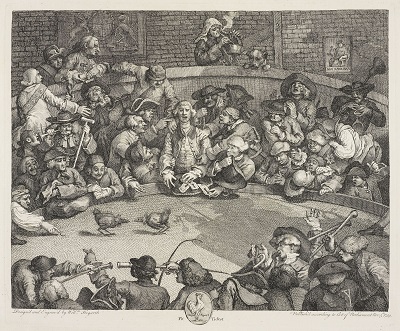| The George Hotel (Inn), Amesbury |
 The George Hotel in Census Returns
The George Hotel in Census Returns
Amesbury, a town in Wiltshire north of the cathedral town of Salisbury, is near the prehistoric monument of Stonehenge.
The George in Amesbury, operating as an inn in the 16th century, has continued business, almost certainly occupying the same site on the High Street, to the present day. A timber framed building was built about 1560 after the inn was damaged by fire. Renovations were done after another fire in 1751. About 1908 the accommodation was expanded with the addition of a new brick wing (1).
During the English Civil War, the George became an overnight stay and headquarters for the Parliamentary commander-in-chief Thomas Fairfax on 29/30 June 1645. He was urged by the preacher Hugh Peters to demolish ‘the monuments of heathenism at Stonehenge’. Fairfax would have had neither the time nor resources to consider this. After his success at the Battle of Naseby on 14 June 1645, Fairfax led his army at a fast pace of 17 to 20 miles a day heading southwest to relieve Taunton. On 1 July, Fairfax and the New Model Army marched from Amesbury to Broad Chalke, a town to the southwest of Salisbury, and on the following day they arrived at Blandford in Dorset (2).
19th Century Travellers
A notice in The Bath Chronicle on 8 August 1816 informed readers that the Duke of Wellington, the victor at the Battle of Waterloo, had been a vacationer at the George Inn:
The Duke of Wellington quitted Cheltenham on Wednesday . . . .
The Duke slept at the George Inn, Amesbury; and next morning he rode on horseback over the park and pleasure-grounds of Lord Douglas, took a view of Stonehenge, and afterwards continued his journey.
A travel review, printed in The Gentleman’s Magazine in 1821, gave a high rating for the George: (3)
After attending Divine service in the magnificent Catherdral at Salisbury on the 30th of Sept. 1821, we drove immediately by an erroneous and very circuitous road, to the foot of Old Sarum . . . . in due time we arrived at the George in Amesbury; where fine eels excellently dressed, rump steaks, and bottled porter, with every other desireable accommodation, gladdened our hearts . . . .
An announcement that the George Inn was under new management was placed in The Salisbury and Winchester Journal on 21 August 1837:
|
In the days of coach travel, posting was the stabling of horses and carriages for the use of travellers.
Tourism to Stonehenge was boosted in 1847 by the opening of passenger service on the railway line from London to Salisbury (4).
In 1848 the American poet Ralph Waldo Emerson, with his travel companion the Scottish born writer and philosopher Thomas Carlyle, booked accommodation at the George Inn for their tour to Stonehenge. On 7 July they took the South Western Railway through Hampshire to Salisbury and then boarded a horse-drawn carriage to Amesbury where they had dinner at the George Inn (5).
The visionary designer William Morris was a guest at the George Inn on 19 August 1879 when he posted a letter to his wife Jane to inform her: (6)
We got to Salisbury last night, and today drove here through the lovely chalk valley by the water (Avon) side . . . .
This is a village [Amesbury] hard by Stonehenge which is its chief attraction, though it is a beautiful place, with a very fine church: I was very much impressed by Stonehenge . . . . Tomorrow we drive on to Marlborough. . . .
In 1879, at the time of the visit of William Morris, the manager of the hotel was John Wheeler (see the record in census returns). An example of the prices can be viewed:
Bill from the George Hotel, Amesbury
Charles Dickens
In 1832 the young Charles Dickens, aged 20, started work as a newspaper reporter. His travels to the provinces to cover by-elections, public meetings and festivities required long coach journeys where he experienced the inns and posting-houses of the pre-railway era (7).
Dickens scholars have debated about the location of the Blue Dragon Inn, featured in Martin Chuzzlewit, in the ‘little Wiltshire village within an easy journey of the fair old town of Salisbury’. A claim is that the George at Amesbury was the inn. In a 1906 publication Charles G. Harper wrote that the landlord of the George Hotel proudly showed visitors Martin Chuzzlewit’s bedroom. In reality, Dickens may have created the Blue Dragon Inn as a composite of several inns including the George at Amesbury as well as the Green Dragon at Alderbury, near Salisbury (8).
A Meeting Place
The George Inn (Hotel) was the venue for a variety of social events and meetings. It was here that, as an annual tradition, the lord of the manor gave a dinner for his tenants (9).
In about 1735 the inn had a cockpit and a skittle alley for playing a game similar to bowling (10). The drama of a boisterous crowd who gathered at the entertainments of Georgian England was the subject of satirical prints by the artist William Hogarth.
|
The Amesbury Coursing Club, founded in 1822, practised an equestrian sport for hunting hares. The Devizes and Wiltshire Gazette, 28 November 1822, reported that the George Inn provided catering:
The Amesbury Coursing Club held their first meeting on Wednesday, Thursday, and Friday last. A numerous and highly respectable assemblage of gentlemen were on the field each day, plenty of hares were found, and the sport proved most excellent. . . . The above meeting was attended by Lord Arundell, Lord Lisle, Sir H. Vivian, Sir J. Hawkins, Capt. Alex. Wyndham, &c. &c. An excellent dinner was provided each day at the George Inn, by Mr Whitehorn.
A group named the Druid Friendly Society had their inaugural meeting at the George Inn, Amesbury in 1853. Monthly meetings with food and drink were scheduled with a start time of 6:30 in the evening. This group, formed to serve the needs of the local community, was not directly affiliated with the magico-religious order of the Druids. Their pamphlet "Rules to be observed by the members of the Druid Friendly Society: to be held at the house of E H Smallbone, George Inn, Amesbury Wiltshire" is in the collection of the Wiltshire Libraries (11).
On 13 May 1854 The Salisbury and Winchester Journal described a lively social evening:
Amesbury – The Druid Friendly Society held their first annual meeting on Thursday se’nnight [sevennight], at the George Inn, when the finances of the Society were examined and found to be in a very prosperous condition. The members, with a few select friends, afterwards partook of an excellent dinner, provided by their worthy host, Mr. E. H. Smallbone. The cloth having been removed, the usual loyal and patriotic toasts were drunk; after which the musical portion of the company highly gratified their friends by the performance of several duetts, trios, catches, glees, and appropriate airs, and the enjoyments of the evening were prolonged till a late hour, when the party separated in peace, and will long remember the first meeting of the Druid Friendly Society, as one in which each endeavoured to promote the happiness of others, and unity, peace, and concord pervaded all.
The Amesbury Turnpike trustees would occasionally meet at the George. Turnpike trusts were set up to maintain roads and collect tolls from the road users. The ‘turnpike’ was the gate which halted traffic until the toll was paid at the tollhouse built by the turnpike gate (12). The Devizes and Wiltshire Gazette, 13 November 1823, gave notice of an upcoming auction at the George Inn:
Amesbury Turnpike – Notice is hereby given, that the tolls arising from the several Toll Gates undermentioned, will be let by auction, to the highest bidder, at the sign of the George Inn, at Amesbury, in the county of Wilts, on Wednesday the nineteenth day of November next, between the hours of ten and twelve in the forenoon, in the manner directed by the Acts passed in the 3d and 4th years of the reign of his present Majesty King George the Fourth, for regulating Turnpike Roads, such letting to commence from the 24th day of November next, and will be put up at such sums as the Commissioners shall think fit.
Mullen’s Pond and Fifield Gates.
Countess Gate.
West Amesbury Gate.
Heytesbury and Chittern Gates.
Wily and Deptford, the Side Bar at Deptford, and Langford.
Bulford Gate.
A notice of the Annual General Meeting of the Amesbury Turnpike trustees,
scheduled to take place at the George Inn, was printed in The Salisbury and
Winchester Journal,
Amesbury Turnpike – Notice is hereby given, that the General Annual Meeting of the Trustees of this Turnpike will be holden at the House of Robert Cox Crocker, the George Inn, Amesbury, in the county of Wilts, on Monday, the thirtieth day of this instant April, at eleven o’clock in the forenoon, for the purpose of auditing the Treasurer’s Accounts, and on other matters.
Matthew Thomas Hodding, Clerk to the Trustees. Salisbury.
The expansion of the railways hastened the end of the age of coaching. The Amesbury Turnpike Trust was wound up in 1871; and an auction was held at the George Inn, Amesbury, to sell the trust’s tollhouses, gates and assets (13).
A guide dated 1900 provided the information that the George Inn, Amesbury was the headquarters of the Hawking Club (14).
Soldiers and Pioneer Aviators
In 1897 the Army started land purchase on Salisbury Plain for the purpose of establishing a military training centre (15). Melville Whistler, the manager of the George Hotel, was quick to market the hotel to attract business from the military camp. An advertisement was placed in Kelly’s 1898 Directory of Wiltshire:
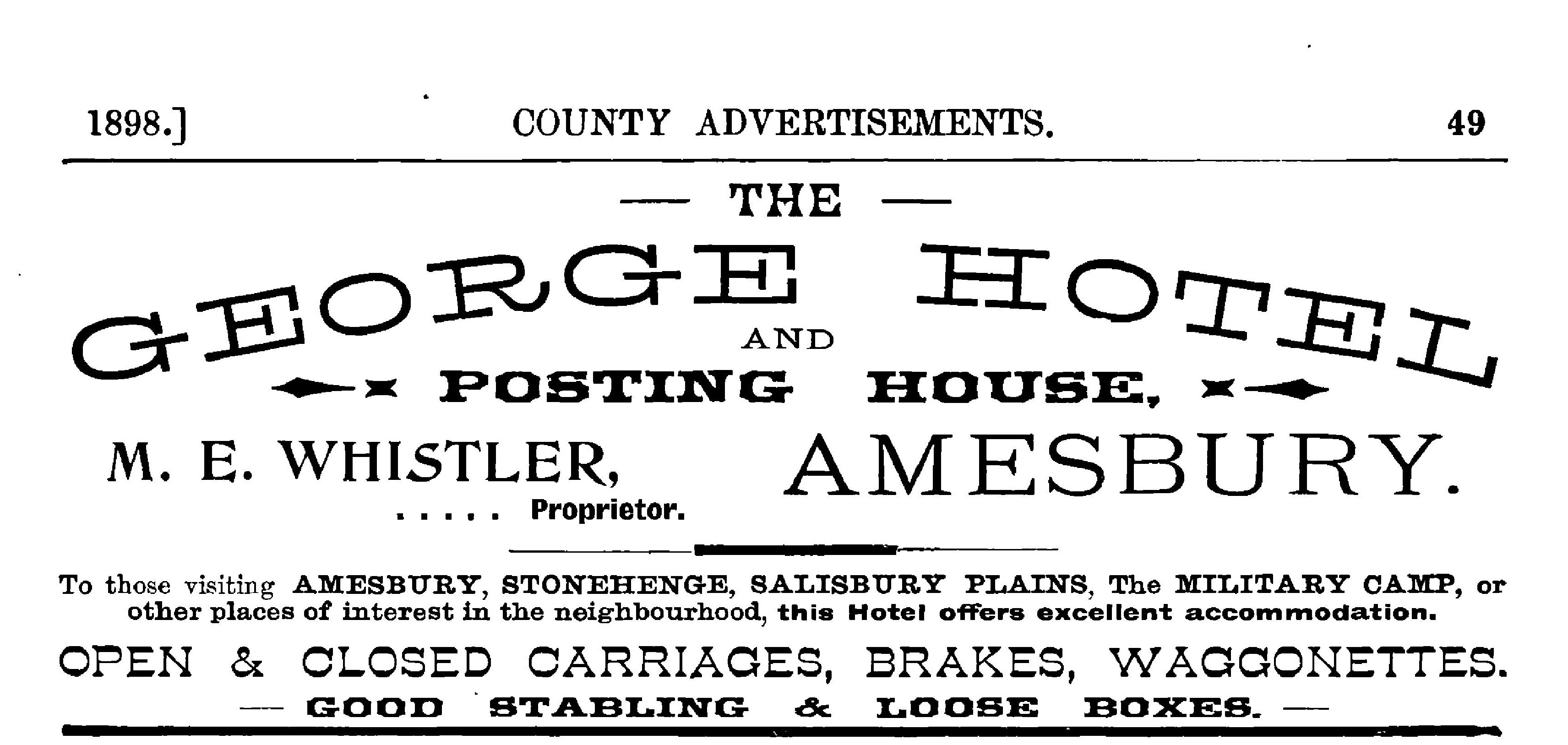 |
The notice highlighted the attractions of "The George Hotel and Posting House":
To those visiting Amesbury, Stonehenge, Salisbury Plains, the Military Camp, or other places of interest in the neighbourhood, this Hotel offers excellent accommodation.
On census day 31 March 1901 a number of members of the Royal Field Artillery were residents at the George Hotel.
The pioneer aviators, who tested their flight skills on the Salisbury Plain,
brought more business to the George Hotel.
Land for an airfield was purchased in the parish of Upavon,
During the 1914–1918 war the George Hotel at Amesbury served as an officers mess until buildings were ready for use at Boscombe Down (17).

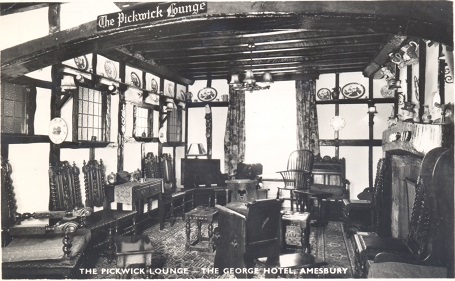 |
| Photograph postcard: The Pickwick Lounge, The George Hotel, Amesbury. |
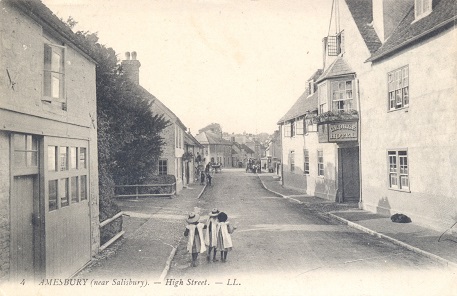 |
| Photograph postcard:
Amesbury (near Salisbury), High Street [1900s].
The sign of the George Hotel is displayed on the building to the right. |
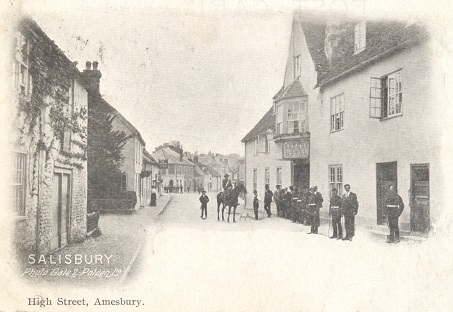 |
| Photograph postcard:
High Street, Amesbury, postally used 1904,
(on back: "Gale and Polden’s Wellington Series. Aldershot"). A group of soldiers, wearing white waist belts, are standing in front of the George Hotel; the sign of The New Inn is on a building at the back left. |
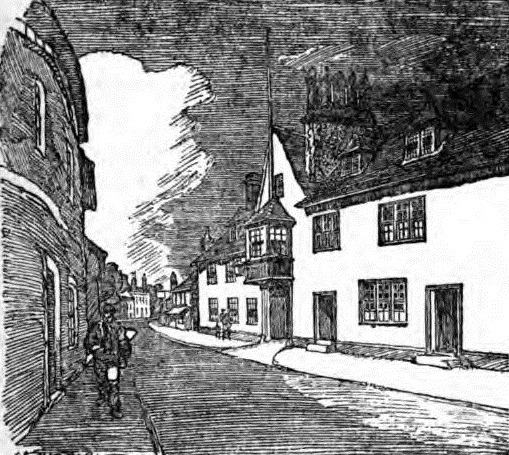 |
| Illustration of The George, Amesbury, drawn by C. G. Harper reproduced in
B. W. Matz, Dickensian Inns and Taverns, 1922, p. 111 (Internet Archive  ). ).
The source of the sketch is: Charles G. Harper, The Old Inns of Old England, Volume 1 of 2, 1906, p. 284 (The Project Gutenberg eBook). |
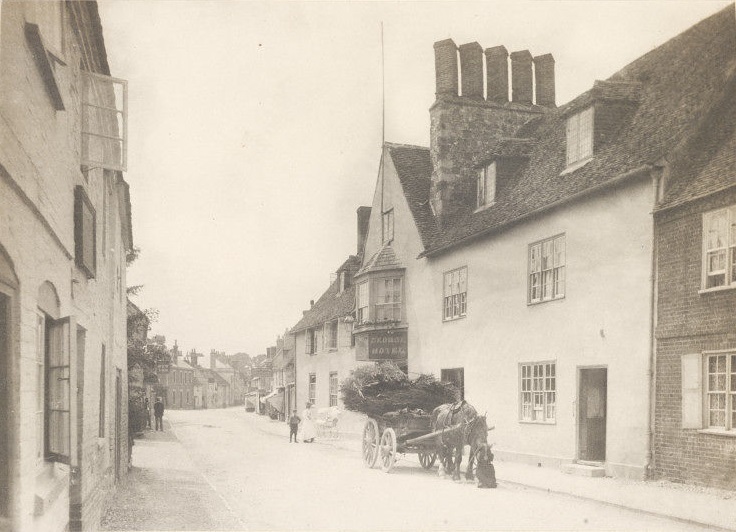 |
| Photograph of The George Hotel Amesbury, 1900, by H Snowden Ward
from the National Photographic Record and Survey: ‘Inns referred to by Charles Dickens’, collection of the Victoria and Albert Museum, London. |
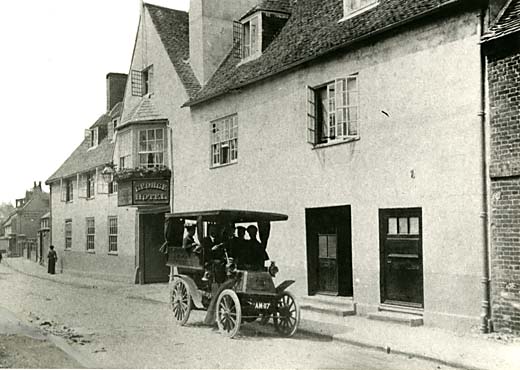 |
| Photograph of The George Hotel with Daimler wagonette,
High Street, Amesbury, Wiltshire, 1904. Wiltshire Historic Photograph Collection, Wiltshire Treasures Website  . .
|
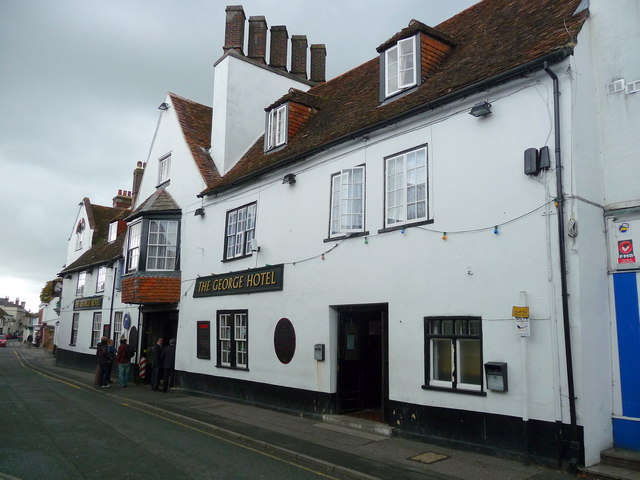 |
| The George Hotel in the High Street, Amesbury.
Photograph © Chris Talbot taken 17 September 2011, The Geograph Britain and Ireland project  . .
|
The George Hotel, Amesbury – Views from the other direction
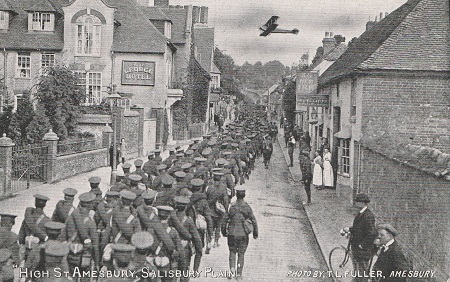 |
| Photograph postcard: First World War
"High St Amesbury, Salisbury Plain" "Photo by T. L. Fuller, Amesbury". On the building to the left, the sign of the George Hotel is mounted on the brick wing, at the south-west end, built in about 1908. |
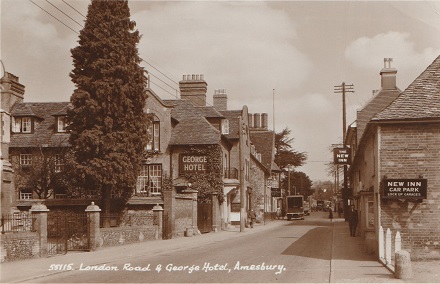 |
| Photograph postcard: "London Road & George Hotel, Amesbury".
Published by E.A. Sweetman & Son Ltd of Tunbridge Wells, posted from Salisbury in 1955. The sign of the George Hotel is on the building to the left. The sign of the New Inn is on the building to the right. |
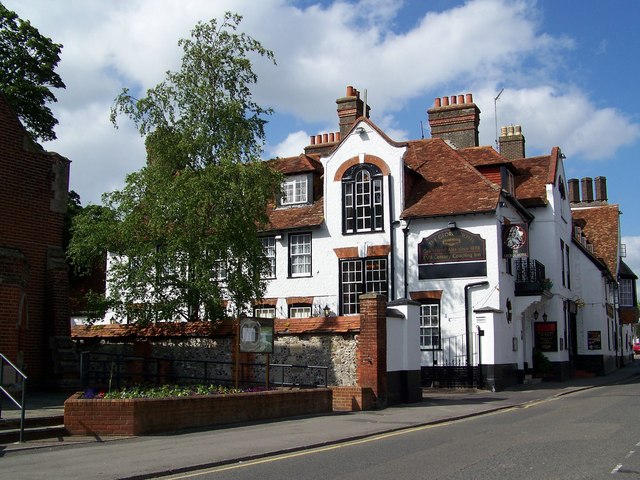 |
| The George Hotel, Amesbury.
Photograph taken 28 June 2008, The Geograph Britain and Ireland project  . .
|
The George Hotel in Census Returns
General Sources
The searchable collection of British Library Newspapers online was
accessed to find newspaper articles from:
The Bath Chronicle;
Devizes and Wiltshire Gazette; and
The Salisbury and Winchester Journal.
Notes
(1)
Amesbury,
A History of the County of Wiltshire  ,
Vol. 15, Victoria County History.
,
Vol. 15, Victoria County History.
(2)
Visitor’s Guide to Historic Amesbury, Amesbury Museum;
John Wilson, Fairfax: A Life of Thomas, Lord Fairfax, London, 1985, p. 76;
Florene S. Memegalos, George Goring (1608–1657): Caroline Courtier and
Royalist General, 2007, p. 280.
(3)
The Gentleman’s Magazine and Historical Chronicle from July to December,
1821,
(4)
London
and South Western Railway  .
.
(5) Ralph Waldo Emerson, English Traits, Chapter 16: Stonehenge.
(6) The Collected Letters of William Morris, Volume I: 1848–1880, 1984, p. 517.
(7) J. B. Priestley, Charles Dickens and His World, Thames and Hudson, 1961, reprinted 1978, p. 17.
(8)
Charles G. Harper, The Old Inns of Old England, Volume 1 of 2, 1906,
pp. 282–287
(The Project Gutenberg eBook);
Michael and Mollie Hardwick, Dickens’s England, 1970, pp. 91–92;
Nancy Aycock Metz, The Companion to Martin Chuzzlewit, 2001, pp. 42 & 44.
(9) John Chandler and Peter Goodhugh, Amesbury, history and description of a south Wiltshire town, second edition, 1989, p. 125.
(10)
Amesbury,
A History of the County of Wiltshire  ,
Vol. 15, Victoria County History.
,
Vol. 15, Victoria County History.
An illustrated history of skittles is at the webpage:
Skittles and
Nine Holes, or Bumble Puppy: sporting pastimes in the Georgian era
 .
.
(11) Ronald Hutton, Blood and Mistletoe, The history of the Druids in Britain, Yale University Press, 2009, p. 217.
(12)
Interesting history is:
Turnpike Trusts  ;
;
Turnpikes
and tolls  , Living Heritage, UK Parliament; and
, Living Heritage, UK Parliament; and
The Amesbury Turnpike Trust  .
.
A toll house, built for the Amesbury Turnpike Trust, is now a heritage building:
Toll
Cottage, Countess Road  , Amesbury
(Historic England online database).
, Amesbury
(Historic England online database).
(13)
John Chandler and Peter Goodhugh, Amesbury, history and description of a
south Wiltshire town, second edition, 1989, p. 38.
The 7 September 1871 issue of The Bath Chronicle noted:
"The Amesbury Turnpike Trust will expire on the 1st November next, when the
mortgage debt will be extinguished".
(14)
Florence Caroline Mathilde Antrobus of Amesbury Abbey,
A sentimental & practical guide to Amesbury and Stonehenge,
compiled by Lady Antrobus, Amesbury, Wiltshire, 1900,
Internet
Archive  , p. 47.
, p. 47.
(15)
Salisbury
Plain Training Area  , Ministry of Defence.
, Ministry of Defence.
(16)
Upavon, A History of the County of Wiltshire
 , Vol. 10, Victoria County History.
, Vol. 10, Victoria County History.
(17) John Chandler and Peter Goodhugh, Amesbury, history and description of a south Wiltshire town, second edition, 1989, pp. 79–80.
| Copyright © WhistlerHistory All Rights Reserved. |
Disclaimer
Revision date: 2022 |
